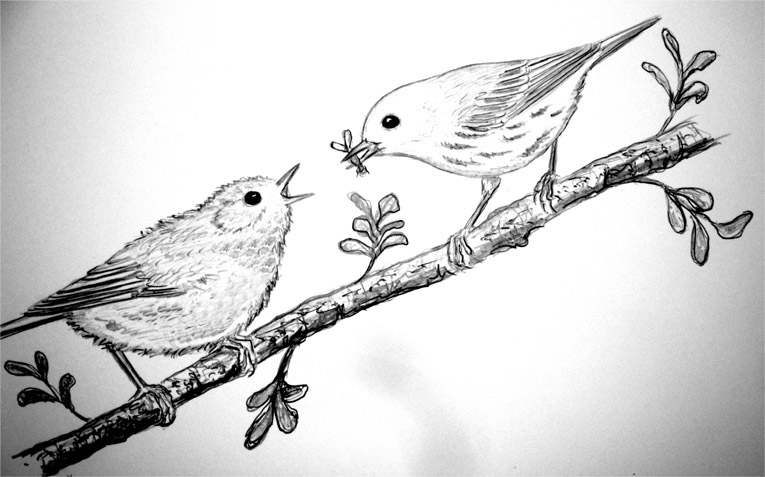
Dear Bird Folks,
On a recent morning walk, I saw a Yellow Warbler feeding a brown bird (see photo). When I got home, I researched Yellow Warblers and learned that these birds are often victimized by Brown-headed Cowbirds. Is the warbler in my photo feeding a baby cowbird?
– Justin, Wellfleet, MA
Good for you, Justin,
Part of the fun of bird watching is learning more about the birds we see on our walks. Even common birds have an interesting secret or two. For example: During the breeding season, House Wrens may gather as many as 500 tiny insects in a single hour. Or how about this? In an effort to cool themselves off, Turkey Vultures have been known to pee on their own legs. That last secret may be more disgusting than it is interesting, but it’s still a secret (and probably should have remained so).
Cape Cod isn’t noted for having a diverse population of warblers. Only four or five species are common local breeders. The bulk of North America’s fifty other warbler species breed to our north, west or south. (No warblers breed to our east; it’s much too wet.) But the cheery Yellow Warbler is happy to call Cape Cod its summer home. As the name implies, Yellow Warblers are vivid yellow (like a goldfinch, only yellower). In addition to his glowing color, the male also has chestnut streaks on his chest. (Some folks refer to these streaks as “lightning bolts,” but I think those people have been reading too many Flash comic books. Just call them streaks.) Many warbler species are difficult for us to see. They spend their lives on the tops of tall trees or hidden in dense foliage, but Yellow Warblers give us a break. They are active and obvious, flitting about in eye-level thickets and hedgerows. And if for some reason you aren’t able to spot a Yellow Warbler, just listen. The males are quite noticeable when singing their classic “sweet, sweet, sweet, I’m so sweet” song. More importantly, they sing so loudly that even I can hear them…sometimes.
A Yellow Warbler’s nest is relatively close to the ground and consists of white milkweed fiber, plant down and silk from caterpillars. The light coloring and lack of height make these nests fairly easy to locate, and that’s not a good thing. Female Brown-headed Cowbirds spend their entire day just looking for unguarded nests and again, that’s not a good thing. For those folks who don’t already know, or don’t remember from my past columns, cowbirds don’t build their own nests. Instead, the female cowbird lays her eggs in another bird’s nest. After laying her egg (typically one egg per nest), the female cowbird moves on. Her egg and eventual chick is left to be cared for by the nest’s owners. It is thought that forty percent of all Yellow Warbler nests are targeted by cowbirds. Forty percent sounds like it should be bad news for the little warblers, but the warbler moms have a plan.
When Mrs. Warbler comes home and finds a cowbird egg in her nest, she may try to hatch it, but frequently she simply builds a new floor onto her nest, trapping the foreign egg in the “basement.” If her own eggs are also trapped under the floorboards, she simply lays more. If the cowbird returns and lays another egg, the mother warbler may build yet another floor. Some Yellow Warblers have added as many as six extra floors onto their nests. That would be pretty cool to see, but it would never happen in Wellfleet. Six floors are totally against the building codes.
The Yellow Warbler’s technique of dealing with cowbird eggs may be clever, but it’s not entirely effective. In fact, Yellow Warblers rank right up there with Song Sparrows and Chipping Sparrows as the most likely to give foster care to baby cowbirds. It’s important to note that while cowbirds impact the success rate of the host family, in many cases they (the hosts) are still able to successfully raise their own chicks… or at least most of them.
This brings us to the photo you sent me. It shows an adult Yellow Warbler feeding a dull brown chick, which is the color of a young cowbird. Was this warbler feeding a brand new cowbird? The answer, in this case, is no. Adult Yellow Warblers may be bright yellow, but their kids aren’t. Instead, they look very much like young cowbirds. There is one important difference, however. Cowbird fledglings are big, three times larger than a warbler. The brown bird in your photo is the same size as the bird that is feeding it; therefore, it’s not a cowbird. It’s an adult Yellow Warbler feeding its own baby. Whew! (Here’s another clue: cowbird and warbler beaks are totally different, but we don’t need to get into that right now; I have to save something for another column.)
This time of year we see lots of birds feeding their babies, Justin. Some babies look exactly like their parents (chickadees), while others look sort of like their parents (robins), and then there are the Yellow Warblers, which we have just discussed. But all of these babies have one thing in common; they’ll all be basically the same size as their parents. But if you see a small bird feeding a much larger bird, the larger bird will most certainly be a cowbird. However, if you see a bird peeing on its own legs, just walk away. You’ll want to get that out of your mind as soon as possible.